Diversification Strategies for Digital Options Portfolios: Minimizing Risk

One of the fundamental principles of digital options, Forex or stock trading is to avoid putting all “eggs” into a single “basket”. This principle is described in most famous books about investment and trading. Diversification strategies are used by both retail traders and huge investment funds. Even banks diversify their assets and strategies to keep making money. By reading this article, you will discover the basics of digital options and Forex trading diversification. We will provide you with useful information about some interesting strategies that you can apply right away. If you have already applied some, create an account at Binolla and start trading now!
Contents
What Is Diversification in Trading in Plain Words
The concept of diversification in digital options and Forex came from stock markets. By buying various stocks and other assets, investors reduced their risks in the past. The idea behind this is simple. If you buy a single currency pair or stock, for instance, its price may plummet and you lose part of the invested money. By allocating funds between two currencies, the chances of covering losses from one of them are higher.
Imagine that you have decided to buy EUR/USD at 1.0800 and diversify your risks by buying AUD/USD at 0.6800. If the first plunges and hits 1.0790 and the second rises to reach 0.6820, your net profit will be 10 pips (-10 pips for EUR/USD and +20 pips for AUD/USD).
Nowadays, traders and investors have access to different types of assets. They are not bound by currencies only. For instance, a trader can purchase a currency pair and gold or oil to diversify their risks.
Investors often use a broader range of assets to diversify their portfolios. Moreover, the number of assets is larger as well. Some portfolios may include dozens of stocks, commodities, currencies, cryptocurrencies, indices, etc. However, even with this richness of assets, the idea is the same. By buying various assets, investors tend to protect themselves from risks that may arise when they buy a single currency or stock.
Types of Diversification Strategies
There are several types of diversification strategies that traders can apply. Some of them are related to adding various assets to their trading portfolios, while others may revolve around using different types of trading strategies.
There are four main diversification approaches that most traders and investors use. They include:
- Asset Diversification. This approach suggests buying various assets to diversify trading or investment activities. Traders can buy currency pairs, stocks, indices, commodities, cryptocurrencies and other assets to mitigate risks;
- Geographical diversification. Instead of trading or investing in assets from one country or region, market participants can create portfolios with a variety of instruments. This will help them overcome political and economic risks that may affect assets belonging to one location. Moreover, such an approach allows traders and investors to get familiar with more opportunities that they may miss by choosing assets from only one region;
- Sector diversification. Traders and investors may choose stocks belonging to a single industry. This may be a good approach if this industry is flourishing. However, in general, it is better to look at other industries and sectors to find more opportunities. Moreover, traders and investors will be able to protect themselves from excessive risks in times of market reversals that may affect a single sector;
- Time horizon planning. Diversification can also be done according to your time horizon and expectations. Some assets may bring you profits right away, while others may be bought and held allowing you to capitalize on their long-term price changes. The latter is relevant for less volatile assets. However, even buying cryptocurrencies and holding them for a while during the hottest crypto seasons may be a great opportunity to build wealth.
Knowing these methods will be very useful for both traders and investors. However, theory is nothing without examples. Find some diversification strategies that you can use in various situations in the following paragraphs.
Splitting Your Trading Balance
This is one of the most popular and widely used approaches by traders. Instead of investing all the money in a single asset, they use only a part of it. According to the Pareto rule, traders can put at risk 20% of their funds and they can gain 80% of profits when trading highly volatile currencies or stocks.
Therefore, if a trader deposits $1,000, only $200 should be used to trade highly volatile assets. If market participants use effective strategies, this amount can bring them $800 by the end of the cycle.
Assets Diversification
By buying different assets, a trader can not only mitigate their risks but also gain money even if one of the assets they have bought fails to grow. We have already provided you with an example in the previous part of the article. Let’s dive deeper into some asset diversification strategies used by traders worldwide.
Buying Two Correlating Currency Pairs
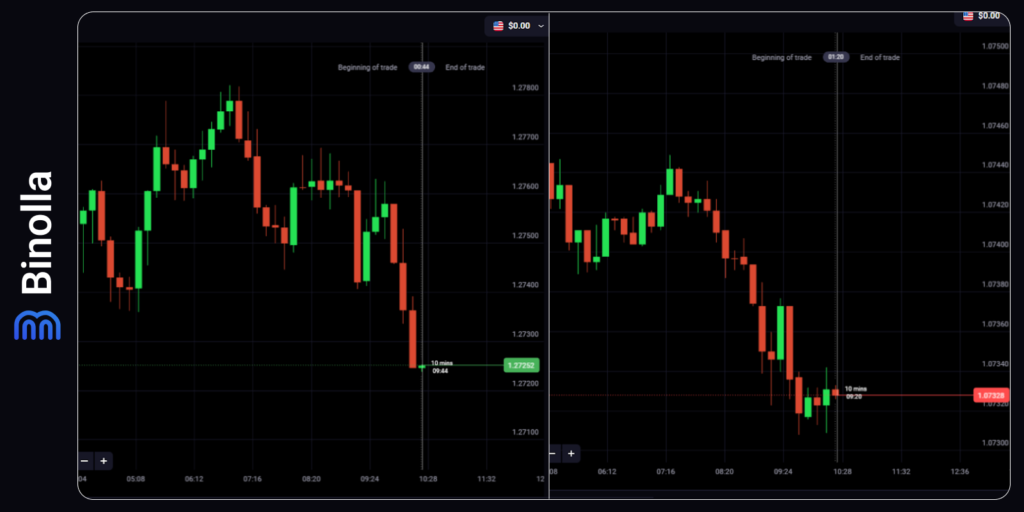
Digital options traders can use this strategy to hedge their risks and cover part of their losses by profiting in one trade. A pair of Higher contracts for EUR/USD and GBP/USD will allow them to earn 60% while losing 100% on the other contract. The difference here is 40%, which means that instead of losing 100%, a trader will lose only 40% in this particular case.
By adding more contracts, one can have even better results. For instance, a trader buys Higher contracts for EUR/USD, GBP/USD and AUD/USD. The first trade fails with a 100% loss, while the remaining two give them 60% and 80% consequently. In this particular case, 100% of losses will be covered by 140% of profits, which makes up 40% of profits in total. As you can see, this strategy allows one to not only cover their losses but also make some gains depending on the contract’s profitability.
FX traders can also use such strategies to buy correlating currencies. However, unlike digital options, those trading Forex CFDs will rely on the number of pips each currency pair makes before the trade is closed.
Let’s consider another example. A trader decides to buy EUR/USD at 1.0750. After a while, the currency pair plunged to 1.0740, which resulted in a total loss of 10 pips. A trader sees that after the New Zealand GDP release, NZD/USD strives upward from 0.6010. They decide to buy this currency pair as well at this level. After a few hours, EUR/USD is traded at 1.0730, while NZD/USD manages to hit 0.6030. The total loss is 20 pips and it is equal to the total profit, which is 20 pips as well.
Later, a trader sees that holding EUR/USD makes no sense as the currency pair shows no signs of recovery. Then they decided to close the trade with a 20-pip loss and hold NZD/USD, which has climbed even higher and reached 0.6035, making a 5-pip profit in total. If NZD/USD continues to rise, the total profit will be even higher.
Buying Currencies with Opposite Correlation
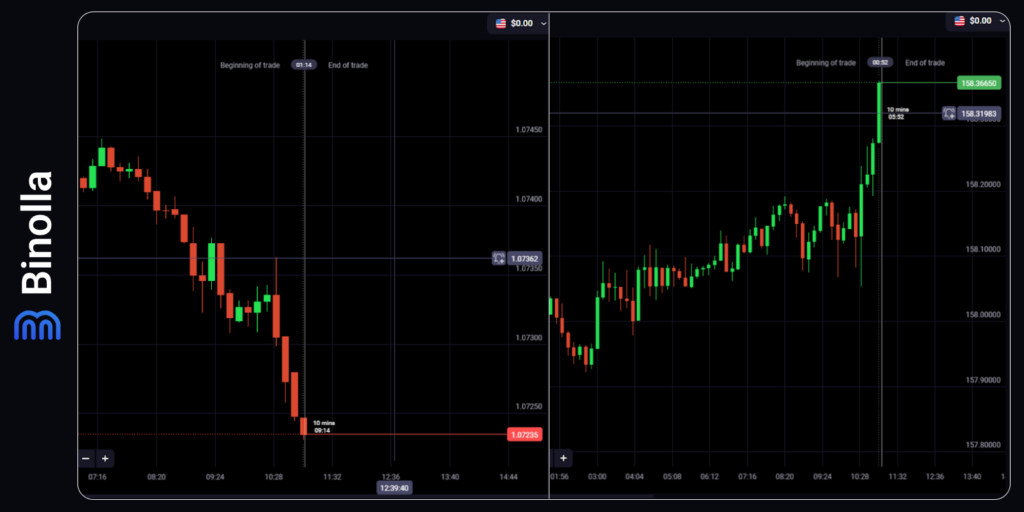
This strategy may be applied by both Forex and digital options traders. The latter can buy EUR/USD and USD/JPY, for instance, expecting that the losses for one currency pair will be partially covered by the profits of another. While this strategy is similar to the previous one, the difference here is that we consider currency pairs with opposite correlations. This means that if EUR/USD rises, USD/JPY will normally plummet and vice versa.
Imagine that a trader has bought a Higher contract when trading EUR/USD with a strike price at 1.0800. They also decided to hedge risks by buying a Higher contract for USD/JPY with 155.00 as a strike price. EUR/USD moved downwards and the contract expired with a 100% loss, while USD/JPY moved higher and the contract expired in the money. Here the difference between profitability matters. If the latter contract’s profitability is 80%, for instance, then the difference between it and the loss will be 20% only. Should a trader invest $10, they would lose $2 instead of $10 in this situation.
Adding another contract to the trading portfolio may be even more attractive. Imagine that instead of buying a Higher contract for USD/JPY to hedge the risks, a trader decides to purchase Higher contracts for USD/JPY and USD/CAD, which have a direct correlation with each other. Both contracts have 80% profitability. Similar to the previous strategy, in this scenario, a trader will have 60% of net profit as their 100% loss for EUR/USD contract will be covered by 160% of profit for USD/JPY and USD/CAD contracts.
Forex CFD traders can use the same approach. However, similar to the previous case, here everything will depend on the number of pips both currency pairs make before a trader closes the trade (or stop loss occurs).
Cross-Market Diversification
Professional traders often refer to various markets when looking for their next trading portfolio diversification opportunities. Apart from buying contracts for currency pairs, market participants can diversify with other assets, including stocks, commodities, and even cryptocurrencies. Similar to both strategies that we have already described, traders should first think about correlation.
All assets can be divided into two groups: those used as safe haven and assets belonging to the group of instruments used when risk appetites are high. EUR/USD, for instance, belongs to the second group, while Gold is a safe haven that is generally bought by investors seeking opportunities to hedge their positions during market turbulence periods.
How does cross-market diversification work? Imagine that you have bought a Higher EUR/USD contract at 1.0800. The price of the asset dropped before expiration and you see that something went wrong and EUR/USD is unlikely to be above 1.0800 at expiration. The choice here may be simply to wait and enter the market in better conditions or try to save the day and buy another Higher or Lower contract depending on the asset you choose.
For instance, you see that gold becomes more attractive as risk appetites are lower. Therefore, you can buy a Higher contract for XAU/USD. If the latter brings you profit, you will cover part of your EUR/USD losses in a similar way that was described in the previous example.
Diversification of Trading Strategies
Diversification in trading is not necessarily related to buying various assets. Traders can also diversify their strategies when trading a single asset to be able to get the most in various market conditions. For instance, if the price is ranging for a while, a trader can apply range-bound strategies that allow them to capitalize on price reversals within the range.
Other strategies may be applied during breakouts. If the market is trending, then a trader can use trend-following methods. Moreover, diversification of trading strategies may include multi-timeframe analysis allowing market participants to be aware of main trends and corrections.
Using Several Timeframes in Trading
Trading with different timeframes may also increase your chances of gaining profits. Traders can use a couple of timeframes to see the current market situation and then make a decision based on longer-term trends.
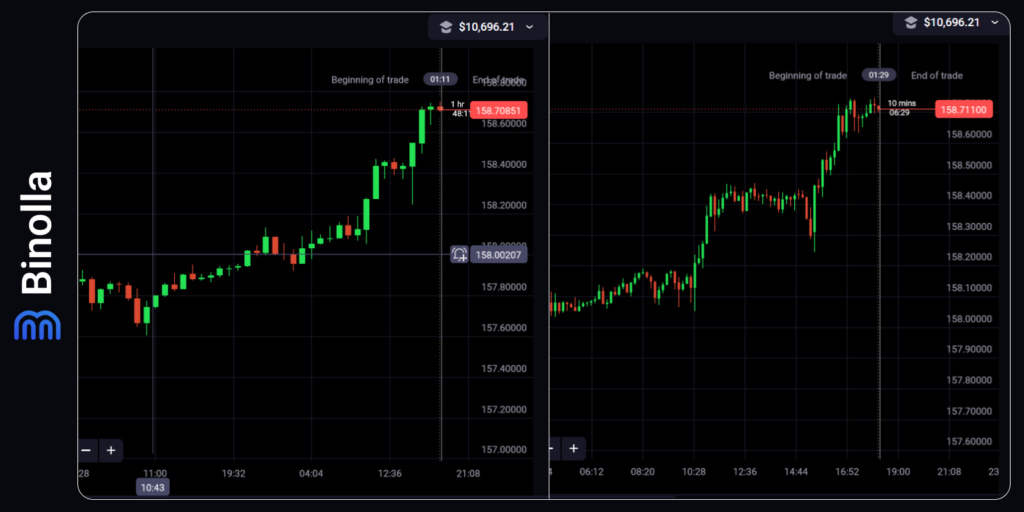
An example can be found on the USD/JPY hourly and minute charts. Hourly charts can be analyzed by a digital option trader as the main where a market participant looks for general trends. After finding one (the uptrend in our case), a trader can switch to a smaller scale to open trades. In this particular case, we have an uptrend on the hourly chart, which means that the best solution for trading on the minute charts is to buy Higher contracts when a signal occurs.
Range-Bound Strategies

Trading in a range may be very profitable and simple as the only thing that a trader needs to do is to wait for the price to test one of the levels. If the price hits the resistance line, then once it begins to go down, a trader can buy a Lower contract or sell an asset. Should the price reverse from the support level, a market participant can buy a Higher contract or simply buy an asset. This strategy works in every channel even if the price is climbing along the ascending trendline or goes down along the descending one.
Breakout Strategies
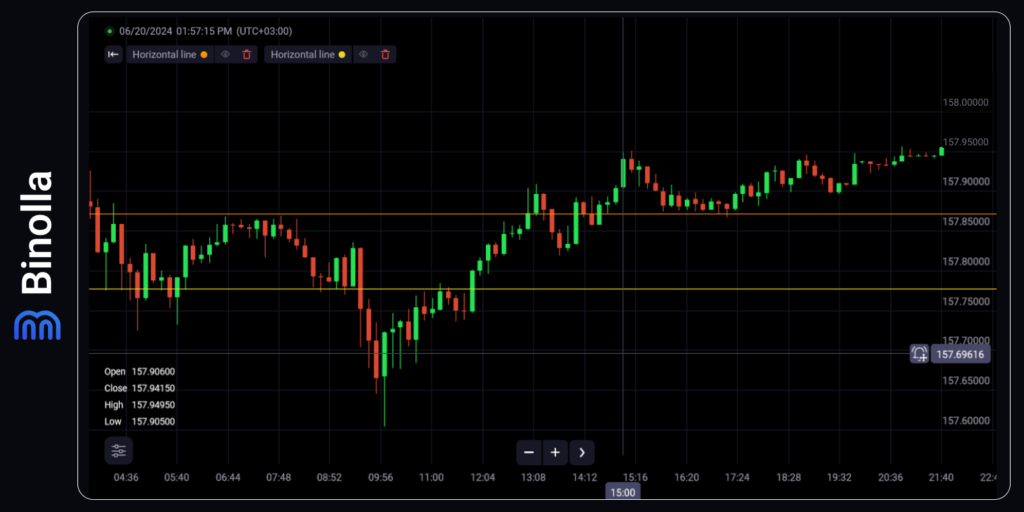
When thinking about diversification, one can add a good breakout strategy to their trading arsenal. This one relies on a simple signal that comes when the price breaks one of the levels. In this particular case, we can see that USD/JPY breaks above the resistance and then manages to stay above. This strategy is good for both Forex and digital option traders. The signal comes when the price crosses the line and closes higher. A trader can buy a Higher contract or simply purchase an asset.
Indicator Strategies
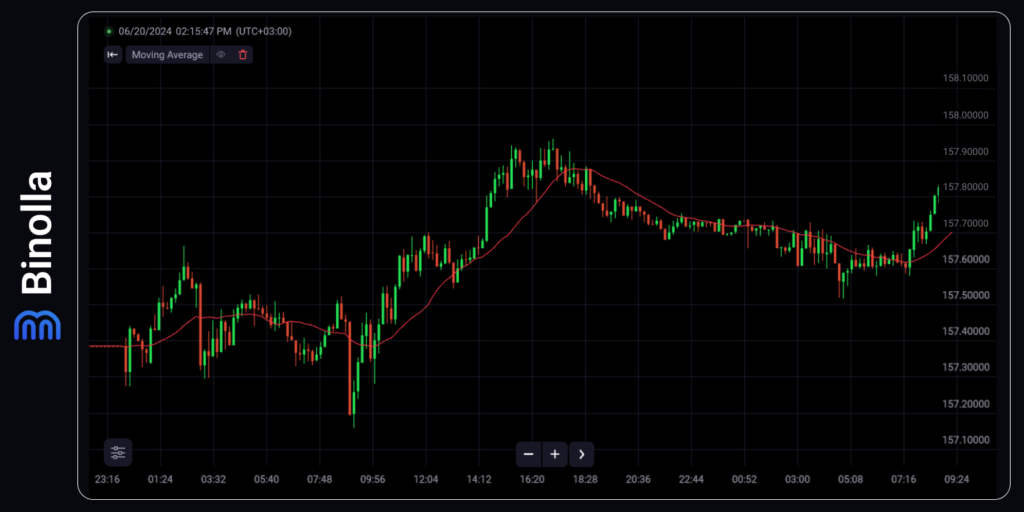
Traders can diversify their trading strategies with those based on technical indicators. One of the simplest ones is a system that uses SMA 20. This one is also known as the Bladerunner strategy. The idea behind it is to buy Higher contracts when the price rejects the ascending moving average and Lower contracts when it fails to break the descending one.
Here we have a situation when the price bounces off the ascending SMA 20, which allows a trader to buy a Higher contract. For FX traders, this can be an opportunity to buy an asset.
Trading Time Diversification
Being attached to a single trading session may be a good idea. However, if you have different assets in your trading arsenal, you may also try different sessions. For instance, if you trade EUR/USD and want to add some other assets that are active during the Asian session, then you can wait for this session to begin and diversify your trading with additional currencies, stocks or other assets.
The only thing that you should remember is that picking trading time should be done carefully as your trading hours should be comfortable. Otherwise, you risk having unexpected losses due to some other activities you should combine with trading.
How to Diversify Digital Options Trading: Hedging Your Trading Activities
In general, depending on your funds’ size, you can diversify digital options trading in many ways. Along with buying option contracts, market participants can invest in the following directions:
- Bank deposits. While bank deposits are among the options with the lowest yield, they allow investors to protect their funds from risks in times of market turbulence. With deposit rates close to inflation rates, this instrument helps market participants save their capital;
- Bonds and other debt instruments. Bonds are among safe haven assets with low yields. However, similar to bank deposits, they can be used by traders and investors to protect themselves from risks during uncertainties. Therefore, allocating part of your free funds to buy bonds may be a good idea;
- Real estate. Investing in real estate is another way to diversify funds. For traders and investors this can be a great opportunity to preserve their wealth and even make an additional source of income as market participants can lease their real estate units.
While various financial market assets may be highly volatile, traders can protect themselves using other instruments. The above-mentioned ways to diversify trading activities are not the only ones, but are among the most popular ones.
Main Benefits of Diversification in Digital Options
Diversification has a lot of advantages that allow traders to improve their performance. Some of the key benefits for digital options traders include:
- Risks mitigation. When buying more than one asset, a trader can mitigate their risks by spreading them across several trading assets;
- Emotional stability. Diversification contributes to better emotional stability as some assets will bring you profit even if other positions are in drawdowns;
- Improved profitability. By creating a rich trading portfolio, a trader improves their chances of gaining profits;
- Multiple market coverage. Diversification allows you to buy assets across different markets.
FAQ

Is Diversification a Good Strategy?
It can be both. Those who know how to diversify will perform better than those who don’t know this method. However, diversification may be risky as well.
Can I Blend Forex Currencies with Other Assets in My Trading Portfolio?
Yes, you can. Traders often use various types of assets to mitigate their trading risks.
What is the Main Downside of Diversification in Digital Options Trading?
The main risk is that a trader makes the wrong choice of assets that may increase their losses instead of protecting their positions from excessive risks.
Can I Use Diversification in Digital Options Trading?
Yes, you can. Several strategies allow you to diversify your asset portfolio as well as apply various systems to improve your trading results.







